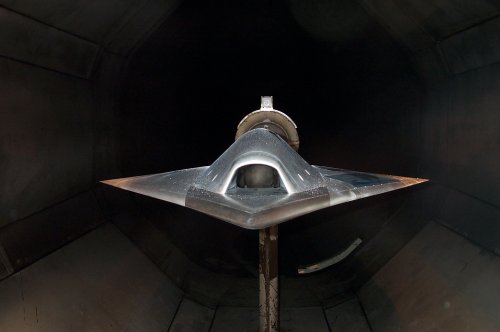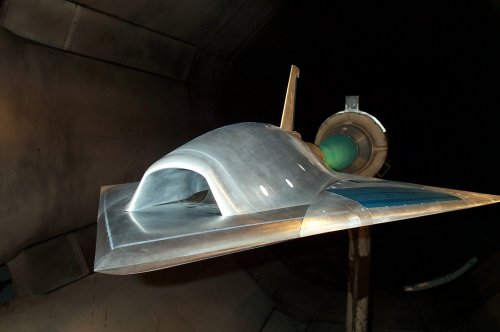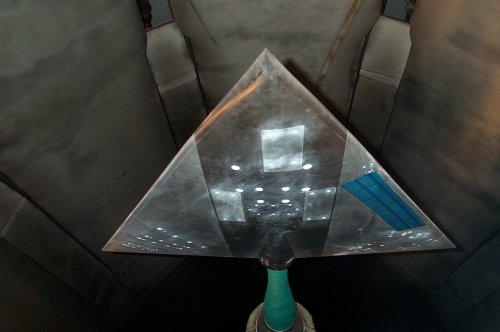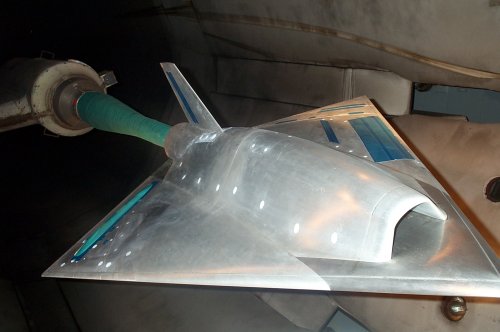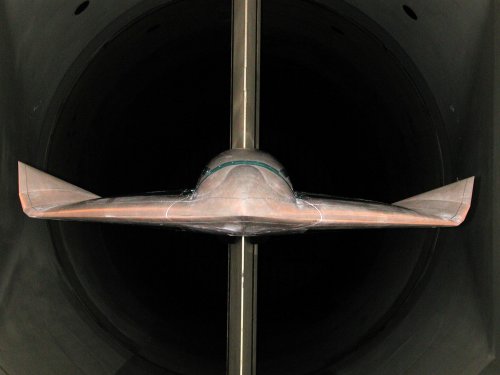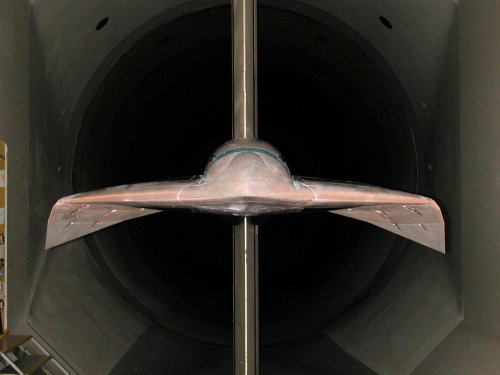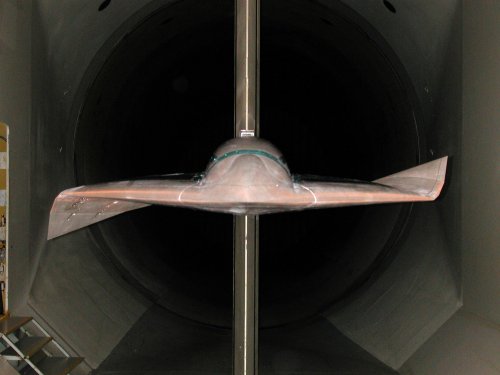- Joined
- 1 April 2006
- Messages
- 10,725
- Reaction score
- 6,727
http://www.nasa.gov/centers/dryden/history/pastprojects/RevCon/index.html
http://www.dfrc.nasa.gov/Newsroom/X-Press/2000/June2/frontfull0.html
NASA selects nine new projects for RevCon
By Beth Hagenauer
Aerospace Projects Writer
NASA's Office of AeroSpace Technology has selected nine aeronautical concepts as part of its Revolutionary Concepts program, which accelerates the exploration of high-risk, revolutionary-breakthrough technologies in atmospheric flight.
Dryden is the lead center for the overall Revolutionary Concepts (RevCon) program, with significant involvement from Ames Research Center, Moffett Field, Calif.; Glenn Research Center, Cleveland, Ohio; and Langley Research Center, Hampton, Va. The projects listed below will receive approximately $300,000 each for Phase I research.
Advanced Supersonic Propulsion and Integration Research aims to validate a two-dimensional, mixed-compression engine inlet for commercial applications. This project will also strive to validate the effectiveness of a propulsion/airframe integration design for reducing sonic boom signatures to levels low enough to allow supersonic flight over land. An additional objective is to establish a Light Detection and Ranging (LIDAR) sensor for detecting atmospheric turbulence that affects supersonic inlet performance.
Glenn will lead this project with partners Dryden; Lockheed Martin Skunk Works, Palmdale, Calif.; United Technologies Research Center, East Hartford, Conn.; General Electric Aircraft Engines, Cincinnati, Ohio; Techland Research, North Olmsted, Ohio; Gulfstream Aerospace, Savannah, Ga.; and the Air Force Research Laboratory, Dayton, Ohio.
APEX is a highly instrumented, remotely piloted glider that will be air-launched at an altitude of 100,000 feet by a balloon. It will be rotated to level flight with rocket assist and be remotely piloted from Dryden. It will obtain data to validate aerodynamic design codes and techniques for a high-subsonic, low-Reynolds-number flight regime. Dryden leads a team that includes Ames, Langley and Glenn.
Joined-Wing Integrated Structures Flight Demonstration is a revolutionary airborne surveillance concept consisting of a joined-wing aircraft with radar apertures integrated into the four joined wings. Langley is the lead with partners from Dryden; The Boeing Company, Phantom Works Division, Seattle, Wash.; Naval Air Systems Command, Patuxent River, Md.; and the Air Force Research Laboratory.
The team will focus on an advanced concept that will enable the integration of large apertures into smaller aircraft for reduced system costs, reduced drag and weight for improved aircraft speed and endurance, and increased aperture size for improved detection range and resolution. Flight experiments will be conducted with a piloted flight demonstrator using a modified Viking S-3 fuselage with new wings.
The Reliable Autonomous Control Technology project will develop an autonomous management system that integrates spacecraft algorithms and advanced fighter vehicle management system technologies to develop the capability for uninhabited aircraft to achieve reliability equivalent to current inhabited aircraft. Dryden is the team lead, with partners Lockheed Martin Tactical Aircraft Systems, Fort Worth, Texas; Lockheed Martin Skunk Works; and the Jet Propulsion Laboratory.
Revolutionary Propulsion for Aeronautical Vehicles is the combined effort of the lead General Electric Aircraft Engines, Cincinnati, Ohio, and partners General Electric Corporate Research and Development, Schenectady, N.Y.; Lockheed Martin Tactical Aircraft Systems; Advanced Projects Research, Inc., La Verne, Calif.; Air Force Research Laboratory; Glenn and Dryden.
This team will design and develop a pulse-detonation technology to integrate with an existing engine and provide increased thrust and fuel efficiency. Flight experiments will be performed using an F-15 aircraft with the detonation device installed in the afterburner portion of one of the engines. Military and commercial aircraft and industrial powerplants will benefit from investigating detonation-based propulsion.
The Shape Memory-Alloy Variable Area Fan Nozzle project will address the development of smart-material actuation for a variable-area fan nozzle. Light-weight, reliable methods of achieving up to 20 percent on-demand nozzle area change will enable development of the next generation of efficient, high-bypass-ratio jet engines, improving efficiency at all flight conditions as well as providing for modest thrust vectoring for attitude control.
United Technologies Research Center will lead the project with support from partners Pratt and Whitney, East Hartford, Conn.; Northrop Grumman, Los Angeles, Calif.; Dryden, Glenn and Langley.
Smart Vehicle - Advanced Technology Demonstrator consists of an uninhabited technology demonstrator that will showcase innovative, hingeless aerodynamic effectors that will increase the maneuverability and performance of the vehicle with reduced signature. An advanced autonomous management system will provide health monitoring, fault detection, systems identification, control design, and control allocation and reconfiguration.
This project will be led by Langley with partners Lockheed Martin Tactical Aircraft Systems; Physical Sciences, Inc., Andover, Mass; Tel Aviv University, Israel; Naval Air Systems Command, Patuxent River, Md.; and Dryden.
Swashplateless Flight will be demonstrated by the team of Advanced Technologies, Inc., Newport News, Va.; Diversified Technologies, Inc., Bedford, Mass.; Ames, Dryden and Langley. The mechanical swashplate, used on every successful rotorcraft flown to date to control the pitch of the blades, represents a single point failure in typically redundant flight control paths.
The team will integrate an on-the-blade, electromechanical servo-actuator into a civil helicopter and demonstrate primary flight control without using a mechanical swashplate. Primary flight control will be demonstrated at Dryden, while noise and vibration reduction tests will take place at Advanced Technology's flight test facilities.
The goal of the Variable Diameter Tilt Rotor flight experiment is to advance the technological readiness of a concept that optimizes the rotor configuration for hover and cruise flight. The project will use next-generation design tools and uninhabited experimental aircraft to qualify the relative merits of a variable diameter rotor capability on tiltrotor vehicle performance, external acoustics and engine-out capability. This project joins Sikorsky Aircraft Corporation, Stratford, Conn., as the lead with Dryden, Ames and Langley.
The proposal teams selected for Phase 1 are expected to complete agreement negotiations by July 1. Systems analysis and feasibility studies will be conducted until May 2001 when Phase 1 activity is completed. The projects will provide an updated Phase 2 proposal for review and evaluation and several projects will be selected for Phase 2.
The projects awarded Phase 2 status in July or August of 2001 will focus on the planning, maturation, development and flight test of the vehicle and/or technology demonstrations.
Revolutionary Concepts in Aeronautics - RevCon, was conceived to provide a means to accelerate the exploration of high-risk, breakthrough technologies to enable revolutionary departures from traditional approaches to air vehicle design. The means to accomplish this was by supporting sub-projects selected from proposals submitted by NASA Research Announcement (NRA), which invited the aerospace community to submit proposals with aeronautical concepts that were revolutionary in nature and not just evolutionary. Partnerships between government, industry and universities were encouraged with cost sharing an important element in the criteria for selection. RevCon was a project-level activity funded through the Flight Research R&T Base program. The lead center was Dryden Flight Research Center with significant participation by Ames Research Center, Moffett Field, Calif., Glenn Research Center, Cleveland, Ohio, and Langley Research Center, Hampton, Va. Funding for the Revolutionary Concepts project ended on Sept. 30, 2001.
RevCon Goals and Objectives
Revolutionize traditional approaches to advancement of aerospace technology
Accelerate implementation of new design methods to reduce time to develop and certify new flight vehicles and vehicle flight systems
Expand the current portfolio of aerospace technology investigations into non-traditional arenas
Select projects that can benefit from flight experiments to accelerate the technology development
http://www.dfrc.nasa.gov/Newsroom/X-Press/2000/June2/frontfull0.html
NASA selects nine new projects for RevCon
By Beth Hagenauer
Aerospace Projects Writer
NASA's Office of AeroSpace Technology has selected nine aeronautical concepts as part of its Revolutionary Concepts program, which accelerates the exploration of high-risk, revolutionary-breakthrough technologies in atmospheric flight.
Dryden is the lead center for the overall Revolutionary Concepts (RevCon) program, with significant involvement from Ames Research Center, Moffett Field, Calif.; Glenn Research Center, Cleveland, Ohio; and Langley Research Center, Hampton, Va. The projects listed below will receive approximately $300,000 each for Phase I research.
Advanced Supersonic Propulsion and Integration Research aims to validate a two-dimensional, mixed-compression engine inlet for commercial applications. This project will also strive to validate the effectiveness of a propulsion/airframe integration design for reducing sonic boom signatures to levels low enough to allow supersonic flight over land. An additional objective is to establish a Light Detection and Ranging (LIDAR) sensor for detecting atmospheric turbulence that affects supersonic inlet performance.
Glenn will lead this project with partners Dryden; Lockheed Martin Skunk Works, Palmdale, Calif.; United Technologies Research Center, East Hartford, Conn.; General Electric Aircraft Engines, Cincinnati, Ohio; Techland Research, North Olmsted, Ohio; Gulfstream Aerospace, Savannah, Ga.; and the Air Force Research Laboratory, Dayton, Ohio.
APEX is a highly instrumented, remotely piloted glider that will be air-launched at an altitude of 100,000 feet by a balloon. It will be rotated to level flight with rocket assist and be remotely piloted from Dryden. It will obtain data to validate aerodynamic design codes and techniques for a high-subsonic, low-Reynolds-number flight regime. Dryden leads a team that includes Ames, Langley and Glenn.
Joined-Wing Integrated Structures Flight Demonstration is a revolutionary airborne surveillance concept consisting of a joined-wing aircraft with radar apertures integrated into the four joined wings. Langley is the lead with partners from Dryden; The Boeing Company, Phantom Works Division, Seattle, Wash.; Naval Air Systems Command, Patuxent River, Md.; and the Air Force Research Laboratory.
The team will focus on an advanced concept that will enable the integration of large apertures into smaller aircraft for reduced system costs, reduced drag and weight for improved aircraft speed and endurance, and increased aperture size for improved detection range and resolution. Flight experiments will be conducted with a piloted flight demonstrator using a modified Viking S-3 fuselage with new wings.
The Reliable Autonomous Control Technology project will develop an autonomous management system that integrates spacecraft algorithms and advanced fighter vehicle management system technologies to develop the capability for uninhabited aircraft to achieve reliability equivalent to current inhabited aircraft. Dryden is the team lead, with partners Lockheed Martin Tactical Aircraft Systems, Fort Worth, Texas; Lockheed Martin Skunk Works; and the Jet Propulsion Laboratory.
Revolutionary Propulsion for Aeronautical Vehicles is the combined effort of the lead General Electric Aircraft Engines, Cincinnati, Ohio, and partners General Electric Corporate Research and Development, Schenectady, N.Y.; Lockheed Martin Tactical Aircraft Systems; Advanced Projects Research, Inc., La Verne, Calif.; Air Force Research Laboratory; Glenn and Dryden.
This team will design and develop a pulse-detonation technology to integrate with an existing engine and provide increased thrust and fuel efficiency. Flight experiments will be performed using an F-15 aircraft with the detonation device installed in the afterburner portion of one of the engines. Military and commercial aircraft and industrial powerplants will benefit from investigating detonation-based propulsion.
The Shape Memory-Alloy Variable Area Fan Nozzle project will address the development of smart-material actuation for a variable-area fan nozzle. Light-weight, reliable methods of achieving up to 20 percent on-demand nozzle area change will enable development of the next generation of efficient, high-bypass-ratio jet engines, improving efficiency at all flight conditions as well as providing for modest thrust vectoring for attitude control.
United Technologies Research Center will lead the project with support from partners Pratt and Whitney, East Hartford, Conn.; Northrop Grumman, Los Angeles, Calif.; Dryden, Glenn and Langley.
Smart Vehicle - Advanced Technology Demonstrator consists of an uninhabited technology demonstrator that will showcase innovative, hingeless aerodynamic effectors that will increase the maneuverability and performance of the vehicle with reduced signature. An advanced autonomous management system will provide health monitoring, fault detection, systems identification, control design, and control allocation and reconfiguration.
This project will be led by Langley with partners Lockheed Martin Tactical Aircraft Systems; Physical Sciences, Inc., Andover, Mass; Tel Aviv University, Israel; Naval Air Systems Command, Patuxent River, Md.; and Dryden.
Swashplateless Flight will be demonstrated by the team of Advanced Technologies, Inc., Newport News, Va.; Diversified Technologies, Inc., Bedford, Mass.; Ames, Dryden and Langley. The mechanical swashplate, used on every successful rotorcraft flown to date to control the pitch of the blades, represents a single point failure in typically redundant flight control paths.
The team will integrate an on-the-blade, electromechanical servo-actuator into a civil helicopter and demonstrate primary flight control without using a mechanical swashplate. Primary flight control will be demonstrated at Dryden, while noise and vibration reduction tests will take place at Advanced Technology's flight test facilities.
The goal of the Variable Diameter Tilt Rotor flight experiment is to advance the technological readiness of a concept that optimizes the rotor configuration for hover and cruise flight. The project will use next-generation design tools and uninhabited experimental aircraft to qualify the relative merits of a variable diameter rotor capability on tiltrotor vehicle performance, external acoustics and engine-out capability. This project joins Sikorsky Aircraft Corporation, Stratford, Conn., as the lead with Dryden, Ames and Langley.
The proposal teams selected for Phase 1 are expected to complete agreement negotiations by July 1. Systems analysis and feasibility studies will be conducted until May 2001 when Phase 1 activity is completed. The projects will provide an updated Phase 2 proposal for review and evaluation and several projects will be selected for Phase 2.
The projects awarded Phase 2 status in July or August of 2001 will focus on the planning, maturation, development and flight test of the vehicle and/or technology demonstrations.

